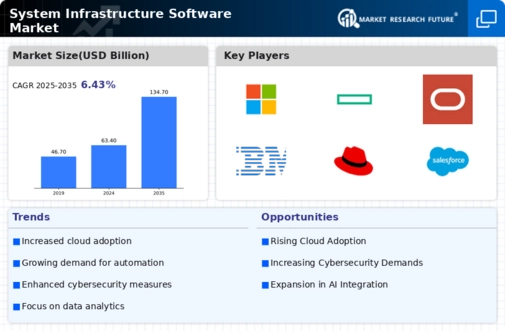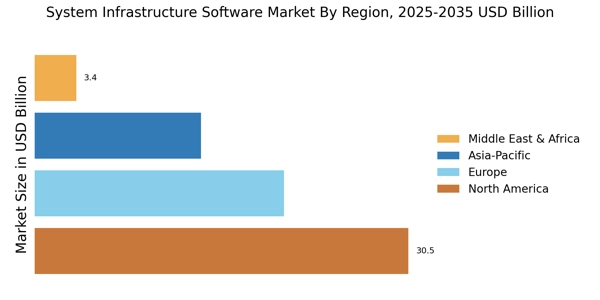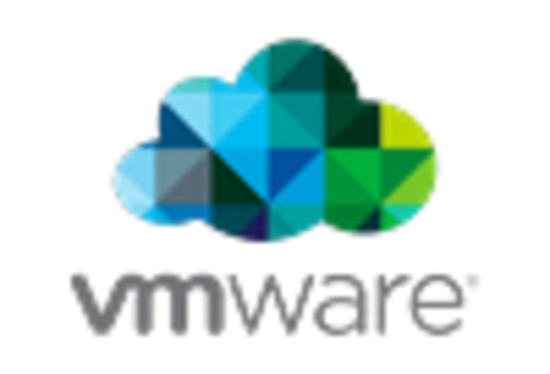Emergence of Edge Computing
The emergence of edge computing is significantly influencing the System Infrastructure Software Market. As organizations seek to process data closer to the source, the demand for software that supports edge computing architectures is increasing. This trend is particularly relevant for industries such as manufacturing, healthcare, and transportation, where real-time data processing is critical. Market analysts project that the edge computing segment will experience a growth rate of approximately 15% over the next few years. This shift necessitates the development of infrastructure software that can efficiently manage distributed computing resources. As businesses recognize the advantages of reduced latency and improved performance, the integration of edge computing capabilities into system infrastructure software is becoming a priority, thereby driving innovation and growth within the System Infrastructure Software Market.
Increased Focus on Cybersecurity
In the current landscape, the System Infrastructure Software Market is witnessing an intensified focus on cybersecurity measures. With the rise in cyber threats and data breaches, organizations are prioritizing the implementation of robust security protocols within their infrastructure software. The market for cybersecurity solutions is expected to grow significantly, with estimates suggesting a growth rate of around 12% annually. This trend indicates that businesses are investing in software that not only supports their infrastructure but also safeguards it against potential vulnerabilities. The integration of advanced security features into system infrastructure software is becoming a standard requirement, as companies aim to protect sensitive data and maintain compliance with regulatory standards. Consequently, the emphasis on cybersecurity is shaping the development and deployment of solutions within the System Infrastructure Software Market.
Shift Towards Hybrid IT Environments
The System Infrastructure Software Market is currently undergoing a transformation with a pronounced shift towards hybrid IT environments. Organizations are increasingly adopting a combination of on-premises and cloud-based solutions to enhance their operational efficiency. This hybrid approach allows businesses to leverage the benefits of both environments, such as scalability and control over sensitive data. Recent studies indicate that nearly 70% of enterprises are expected to implement hybrid IT strategies by 2026. This trend is driven by the need for flexibility and the ability to respond swiftly to changing market demands. As companies seek to optimize their IT infrastructure, the demand for software that can seamlessly integrate and manage hybrid environments is likely to rise, further propelling growth within the System Infrastructure Software Market.
Rising Demand for Virtualization Solutions
The System Infrastructure Software Market is experiencing a notable increase in demand for virtualization solutions. Organizations are increasingly adopting virtualization technologies to optimize resource utilization and reduce operational costs. According to recent data, the virtualization software segment is projected to grow at a compound annual growth rate of approximately 10% over the next five years. This growth is driven by the need for businesses to enhance their IT infrastructure's flexibility and scalability. Virtualization allows for the efficient management of hardware resources, enabling companies to run multiple operating systems on a single physical machine. As enterprises seek to streamline their operations and improve service delivery, the adoption of virtualization solutions within the System Infrastructure Software Market is likely to continue its upward trajectory.
Growing Need for Compliance and Regulatory Standards
The System Infrastructure Software Market is increasingly shaped by the growing need for compliance with various regulatory standards. Organizations are under pressure to adhere to regulations such as GDPR, HIPAA, and others, which necessitate robust data management and security practices. This compliance requirement is driving the demand for infrastructure software that can facilitate adherence to these standards. Recent data suggests that the compliance software market is expected to grow at a rate of around 9% annually. As businesses strive to avoid penalties and protect their reputations, the integration of compliance features into system infrastructure software is becoming essential. This trend not only influences purchasing decisions but also shapes the development of new solutions within the System Infrastructure Software Market, as companies seek to ensure that their infrastructure aligns with regulatory expectations.


















Leave a Comment